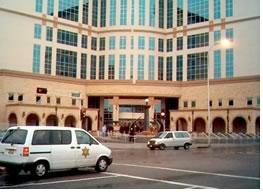
A report from the January 11–13 Albuquerque summit
Editor, AIA Professional Practice
Recognizing that clients and the public at large are demanding a new approach to security design and urban planning, the AIA convened "Building Security Through Design: Protective Environments in an Open Society" January 11–13 in Albuquerque. The multidisciplinary forum of 247 architects, planners, researchers, engineers, academicians, government representatives, and fire-safety and law-enforcement professionals brought a deep accumulation of experience to bear on the complex design considerations for creating a safe and secure built environment. Session topics spanned the scale from aesthetic comfort and sense of safety to the psychology of terror and attack prevention and mitigation.
 The
design professions and construction industries must tackle the country's
newfound sense of insecurity by providing a new scope of services, said
keynote speaker J. Walker Smith, PhD, Yankelovich Inc. The construction
industry must strive to understand the post-September 11 psyche of America,
he said, and provide security measures that are minimally intrusive and,
by focusing on prevention, more effective. Smith proposed that architects
begin thinking of security-conscious design as a highly desirable and
value-adding service. Clients do, he said.
The
design professions and construction industries must tackle the country's
newfound sense of insecurity by providing a new scope of services, said
keynote speaker J. Walker Smith, PhD, Yankelovich Inc. The construction
industry must strive to understand the post-September 11 psyche of America,
he said, and provide security measures that are minimally intrusive and,
by focusing on prevention, more effective. Smith proposed that architects
begin thinking of security-conscious design as a highly desirable and
value-adding service. Clients do, he said.
The conference kicked off with tours highlighting the myriad security challenges in a variety of building types: the GE Engine Plant, Bernalillo County Courthouse, and Albuquerque High School. Sandia National Laboratories ended the first day with a presentation of its building materials research and security assessment tools and tests, thereby setting a foundation for discussions throughout the conference.
Among the research at Sandia is software that helps building managers assess risk from violence and natural disaster for specific building surroundings, construction type, and use; blast simulation software; and blast-resistant glass that minimizes the risk of flying shards. The Sandia National Laboratories work is organized under its Architectural Surety program to make buildings safer and work better through integrated application of risk assessment and mitigation technologies.
Three issue forums—moderated by Gerry Kermouch from Business Week, Ron Lieber from Fast Company, and Steve Ashley from Scientific American—closed the conference with lively panel discussions and generated questions for the building professions to tackle in the days and years ahead.
Copyright 2001 The American Institute of Architects. All rights reserved.
![]()
|
Synopsis from these plenary sessions and the breakout sessions will be posted on the AIA Professional Interest Area Gateway site as they are completed over the next two weeks. Audiotapes of each session are also available through ACTS. For more information on this conference, contact C.D. Pangallo, EdD. For more information on the broad array of AIA efforts regarding building security since last September, visit the Building Security Through Design Resource Center." The site has just been reorganized to make it easier to find the information you need. |
|